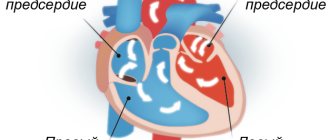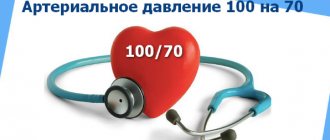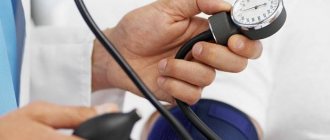Nausea and heart pain
Pain and discomfort appearing in the heart area are an alarming sign. In this way, diseases often appear that pose a serious danger to human health and life. Heart pain and nausea often occur together. How should one act in such a situation, and what pathologies can these symptoms indicate?
Causes of nausea and pain in the heart area
It should be remembered that pain and discomfort in the heart area primarily signals that a vital organ is in danger. Often the appearance of symptoms such as nausea and heart pain requires immediate medical attention. Along with the above symptoms, patients often experience shortness of breath, severe weakness, anxiety, and fear.
Nausea and heart pain can occur simultaneously when the gastrointestinal or cardiovascular system is affected. The most common causes of such symptoms are the following pathologies:
- heart failure;
- attack during myocardial infarction;
- hypertensive crisis;
- vegetative-vascular dystonia;
- acute diseases of the pancreas or liver;
- bronchitis and pneumonia in acute severe form.
Heart failure may include chest pain and nausea. These symptoms are caused by several factors: disturbances in the anatomy of the muscle tissue of the heart, deterioration in the functioning of this organ, the appearance of swelling in the abdominal cavity and chest, as well as increased intracardiac pressure. All this leads to nausea and pain in the heart.
During myocardial infarction, pain and painful, prolonged nausea may appear some time before the attack. This period can be several days. The same symptoms are observed with the acute development of pathology. In addition to these two signs, during an attack caused by myocardial infarction, others are noted: weakness, vomiting, tachycardia, a sharp rise in blood pressure followed by a decline, gradually increasing shortness of breath and an increasing feeling of burning and pain in the chest space. Patients often complain of an unreasonable feeling of fear and anxiety; cases of fainting during an attack are widespread. It is also possible for the pathology to be asymptomatic, in which its only manifestation is nausea.
A hypertensive crisis is a sudden rise in blood pressure. Symptoms of this condition include severe pressing pain in the heart, nausea that leads to vomiting but does not bring relief, and dizziness.
The diagnosis of “vegetative-vascular dystonia” is quite common in our country, but in many other countries it is not made. According to the international classification, similar conditions in which there are signs of disruption of the normal functioning of the autonomic nervous system are called somatoform dysfunctions or disorders. Symptoms that indicate vegetative-vascular dystonia are insomnia, pressure instability, tachycardia, vomiting, nausea and heart pain. All these signs, most often, are of a psycho-emotional nature. There were practically no complications or consequences observed. However, the appearance of such symptoms requires careful attention, a comprehensive examination and, if necessary, proper treatment.
In some cases, pathologies of the gallbladder, pancreas and liver are manifested by pain that is localized or radiates to the heart area. With such diseases, frequent nausea may occur that does not lead to vomiting. Pain can affect the hypochondrium and abdomen. A symptom of gallbladder damage is bitterness in the mouth.
Sharp pain in the chest and nausea are frequent companions of inflammatory diseases of the lower respiratory system. Pain with pneumonia and bronchitis is caused by strong constant overstrain of the intercostal muscles, which occurs with prolonged painful coughing. Nausea is associated with general damage to the body by toxins released by pathogenic microorganisms. In addition, this phenomenon can be a side effect of medications taken. You can determine whether pneumonia or bronchitis is the cause of chest pain and nausea by paying attention to the presence of other symptoms. Thus, increased temperature, increased sweating, chills, runny nose and other signs of damage to the upper respiratory system indicate respiratory diseases.
What to do for heart pain, nausea and dizziness
The appearance of nausea, heart pain, vomiting, weakness must be treated carefully; these symptoms should not be left to chance, as they can have the most dire consequences. A qualified doctor and the modern level of diagnostics allow you to quickly determine the cause of the problem, and then prescribe the necessary course of treatment. In each specific case, a different treatment is prescribed, so you cannot be treated on the advice of friends and neighbors.
The specialist must, in addition to recommendations for treating the underlying disease, prescribe therapy in order to cope with unpleasant symptoms. In addition, he gives advice on organizing a daily routine, necessary rest, opportunities for physical activity and a diet that should be followed.
Urgent medical help should be sought if the following warning signs are present:
- heart pain and nausea do not subside after taking nitroglycerin tablets;
- in addition to nausea and pain in the heart, there is severe shortness of breath, very high blood pressure, the appearance of cold sweat, inexplicable anxiety, fear and restlessness;
- the duration of pain in the heart exceeds a quarter of an hour.
You can get rid of nausea and chest pain only after identifying the causes of their occurrence. Since different pathologies require the use of different drugs and treatment methods.
In case of functional disorders of the heart and blood vessels, you should take medications that lower pressure and normalize the functioning of the heart muscle. The therapeutic complex also includes drugs that have a positive effect on the condition of blood vessels and blood composition.
For vegetative-vascular dystonia, complex treatment is prescribed, including medications that improve the functioning of the nervous system and sedatives. Other treatment methods are also prescribed, such as physiotherapy, therapeutic massage and exercise, reflexology, etc.
A disease such as myocardial infarction requires urgent medical care, which can only be provided in a hospital setting. The course of treatment, its duration and the means used depend on the individual data of the patient and the extent of damage to the heart muscles. The chances of a favorable outcome increase significantly if you consult a doctor in a timely manner (less than 10-12 hours).
Treatment of inflammatory pathologies of the respiratory system depends on the nature of the disease: viral or bacterial. In addition to antivirals or antibiotics, it includes vitamins, mucolytics and detoxification therapy. It is important to choose the right antibiotic for treatment. Although there are broad-spectrum antibiotics that are quite effective, drugs prescribed based on the results of microbiological tests are much more effective.
Diseases of the pancreas, liver and gall bladder require specific treatment to restore the affected organs. To get rid of nausea in such cases, take antiemetics, for example, Zoloft, Cerucal or others. A thorough examination of the patient is imperative.
Causes of pain in the heart area
It is necessary to clearly understand that pain in the heart and nausea are, first of all, alarming signals that make it clear to a person that vital organs are in serious danger, and the current situation requires the use of immediate measures. One way or another, pain localized in the chest and nausea are symptoms of serious diseases; they should not be ignored, because along with them shortness of breath, a feeling of weakness, fear, and anxiety may appear.
Nausea and chest pain can appear simultaneously if several pathologies occur at once: cardiovascular and gastrointestinal. However, most often pain and nausea have the following causes:
• vegetative-vascular dystonia
• heart failure
• heart attack (myocardial infarction)
• pneumonia, bronchitis
• hypertensive crisis
• diseases of the liver, pancreas
Vegetative-vascular dystonia is a common diagnosis in Russia, but in Sweden and Europe there is no such diagnosis. Similar conditions that manifest themselves with a large number of symptoms associated with dysfunction of the autonomic nervous system and neuroregulation of the body in Swedish medicine are designated as somatoform disorders or dysfunctions (Somatoforma störningar, in the international classification of diseases has the number F45). Among the common symptoms of vegetative-vascular dystonia, people often find pain in the heart area, nausea, vomiting, insomnia, tachycardia, and unstable blood pressure. The symptoms that arise speak more about a mental than a physical illness, and almost never lead to serious consequences, although they require a thorough examination and, possibly, adequate therapy.
Nausea and chest pain may be signs of heart failure. Anatomical changes in the heart muscle and a decrease in the physiological functions of the organ contribute to the appearance of edema in the chest and abdominal cavity, and the pressure inside the heart increases. All this leads to pain in the chest, as well as nausea.
A heart attack (myocardial infarction) is sometimes preceded several days by the appearance of pain in the heart and painful nausea. Similar symptoms are also characteristic of the acute process of developing the pathology of a heart attack. Vomiting, nausea, weakness, low blood pressure replace hypertension, tachycardia, while shortness of breath, a feeling of fear and burning pain in the chest increase, and cases of fainting are not uncommon. Often nausea is practically the only symptom of myocardial infarction, and the disease develops painlessly.
Sharp chest pains and a feeling of nausea often accompany bronchitis and pneumonia. Pain in such cases occurs after a prolonged unproductive cough due to overstrain of the intercostal muscles. Nausea is a consequence of general intoxication due to the activity of microorganisms and taking medications. A sign that heart pain and nausea are symptoms of inflammatory diseases of the upper respiratory tract is the presence of elevated body temperature, chills, and increased sweating.
A sharp jump in blood pressure characterizes a hypertensive crisis. In this case, patients experience pressing pain in the heart area, nausea, vomiting, which does not bring relief, and dizziness.
With diseases of the liver, gallbladder and pancreas, pain can be localized in the chest area, and frequent nausea without vomiting also occurs. Often pain is felt in the hypochondrium area, and bitterness may appear in the mouth.
What to do
Chest pain, vomiting, nausea, weakness should not be ignored, they cannot be ignored. Timely diagnosis and consultation with a competent specialist can differentiate the cause of symptoms and direct all therapeutic measures to eliminate the disease. Therefore, it is necessary to find out from your doctor what you can take for nausea. In each specific case, the answer to this question will be different.
It is imperative to follow the doctor’s recommendations regarding the treatment of the underlying disease that causes unpleasant symptoms, as well as adhere to the proposed diet, exercise regimen and rest.
There is no need to hesitate to seek emergency help if there are threatening symptoms:
- heart pain does not stop for more than 20 minutes;
- pain does not go away after taking nitroglycerin;
- an attack of nausea and heart pain is accompanied by high blood pressure, cold sweat, shortness of breath, and fear.
How to Deal with Chest Pain and Nausea
A prerequisite for the successful elimination of chest pain and nausea is an accurate diagnosis of the patient’s condition. After all, to relieve nausea in case of dysfunction of the heart and blood vessels. it is necessary to take medications that lower blood pressure, correct heart function, improve the condition of blood vessels and the rheological properties of the blood. Therapy for vegetative-vascular dystonia is complex and includes sedatives, drugs that optimize the functioning of the nervous system, as well as individual organs and systems. In addition, they also resort to non-drug treatment methods: therapeutic massage, physiotherapeutic procedures, reflexology.
Myocardial infarction requires urgent and competent measures in a hospital setting. Therapy, its duration, and volume directly depend on the area of damage to the heart muscle. The success of treatment is much greater if it is started for the first time 12 hours
Pneumonia and bronchitis, in addition to antimicrobial and antiviral therapy, always includes detoxification agents, vitamins, and mucolytic drugs. Despite highly effective broad-spectrum antibiotics, the most acceptable is the prescription of drugs based on microbiological research data.
For diseases of the liver and pancreas, the use of drugs that restore the function of these organs, as well as antiemetic drugs (Cerucal, Zoloft), helps quite well against nausea. Additional examination methods will not be superfluous; they will help you individually select the necessary therapy.
The causes of heart pain and nausea are varied. By listening to the “voice” of one’s own body, a person is able to timely catch signals of dysfunction of organs and systems, and by consulting a doctor, find the right solution to the problem that has arisen.
Why does my heart hurt?
Anxiety
It's normal to feel anxious from time to time. But if your anxiety gets worse or you have an anxiety disorder, you may experience chest pain and dizziness.
You may also experience:
- headache;
- dry mouth;
- rapid breathing;
- fast heart rate;
- nausea;
- shiver;
- chills;
- excessive worry;
- fatigue;
- gastrointestinal problems.
Nausea
Nausea is a peculiar unpleasant sensation in the epigastric region, chest, and oral cavity, which often precedes vomiting and is often accompanied by general weakness, sweating, increased salivation, cold extremities, pale skin, and decreased blood pressure.
Causes of nausea
Possible causes not related to any disease:
1. Overeating and/or regularly eating foods that are very high in fat;
2. Side effects of medications and penetration of toxic substances into the body;
3. Psychogenic reactions: fear and anxiety, hysteria;
4. Kinetosis (seasickness), accompanied by a feeling of nausea and motion sickness;
5. Pregnancy (morning sickness normally goes away by the end of the first trimester);
6. Exposure to smoke, toxic fumes and various harmful substances;
7. Sunstroke, hyperthermia.
Diseases accompanied by nausea
Diseases that cause nausea are very diverse and can be associated with the digestive, nervous, reproductive, cardiovascular and endocrine systems.
Most often, nausea develops due to pathologies of the gastrointestinal tract, including:
1. acute surgical diseases: peritonitis, appendicitis, acute pancreatitis, acute intestinal obstruction, gastrointestinal bleeding, acute cholecystitis;
2. chronic diseases: gastroesophageal reflux disease (GERD) and hiatal hernia, gastritis, peptic ulcer of the stomach and duodenum, enterocolitis, duodenitis, cholelithiasis, inflammatory bowel disease (Crohn's disease, ulcerative colitis), irritable bowel syndrome, chronic pancreatitis ;
3. malformations of the gastrointestinal tract: narrowing of the pylorus (stenosis), fusion of a section of the gastrointestinal tract (atresia), developmental defects of the pancreas;
4. gastrointestinal tract infections: viral gastroenteritis, food toxic infections, helminthiases;
5. foreign bodies of the stomach, esophagus, intestines;
6. functional disorders accompanied by impaired motor function of the stomach and intestines;
7. liver diseases (hepatitis, cirrhosis of the liver);
8. food intolerances or food allergies.
In addition to disruption of the gastrointestinal tract, nausea can be caused by diseases of other organs and systems:
1. Diseases of the central nervous system: brain tumors and injuries, brain infections (encephalitis, meningitis), increased intracranial pressure.
2. Diseases of the cardiovascular system: hypertension, heart failure, myocardial infarction.
3. Diseases of the inner ear: Meniere's disease, labyrinthitis.
4. Diseases of the endocrine system: in diabetes mellitus – ketoacidosis; thyrotoxicosis, adrenal insufficiency, phenylketonuria.
5. Kidney diseases (urolithiasis, renal failure);
Nausea is associated with cancer treatment (chemotherapy and radiation therapy), imbalance of blood electrolytes, and migraines.
Nausea can be a manifestation of such emergency conditions as poisoning, diabetic ketoacidosis, intestinal obstruction, cerebral hemorrhage, acute cardiovascular pathology, renal failure, liver failure, sepsis.
Most often, nausea does not appear independently, but in combination with other symptoms: abdominal pain, belching, diarrhea, increased gas formation, dyspepsia, vomiting, muscle pain, dizziness, severe fatigue, fever and chills, headache, yellowing of the skin and sclera.
Particular attention should be paid to the combination of nausea with the following symptoms: black stools or the presence of blood in the stool, the presence of blood in the vomit, severe abdominal pain, difficulty breathing, fainting, impaired consciousness, high body temperature (more than 38.5 ° C), rapid pulse, frequent shallow breathing, severe headache, stiff neck. The appearance of these symptoms indicates the development of a life-threatening condition, if detected, you should immediately consult a doctor. You should also definitely see a doctor if you feel sick after a head injury.
Examination of a patient with nausea.
Nausea is a nonspecific symptom of many diseases; therefore, it has diagnostic value only in conjunction with other signs of the disease (for example, with signs of peritoneal irritation in acute appendicitis).
To determine the direction of the examination, it is necessary to conduct an active interview with the patient. So, if nausea is accompanied by other dyspeptic manifestations (belching, a feeling of heaviness in the epigastric region, etc.) and a relationship is identified between the occurrence of nausea and food intake, diseases of the digestive system should be assumed (gastritis, cholecystitis, pancreatitis, stomach tumor, etc.) and conduct a gastroenterological examination; when nausea is combined with headache, sensitivity or movement disorders, a neurological examination, etc. is necessary.
Determine what medications the patient took. Drugs that often cause nausea and vomiting include analgesics, cardiovascular drugs, hormonal agents, antibiotics, drugs that primarily act on the central nervous system, and antineoplastic agents. Drug use or withdrawal may also cause nausea or vomiting. If discontinuation of a drug is accompanied by the disappearance of nausea, we can assume that this disorder is associated with taking the drug, but it is necessary to ensure that there are no symptoms for a significant period of time after discontinuation of the drug.
An objective examination reveals an “acute abdomen” and other life-threatening conditions. If the cause of nausea has not been established, a laboratory examination is performed:
1. general blood test (possible anemia, leukocytosis, accelerated ESR in case of gastric ulcer, duodenal ulcer, ulcerative colitis, etc.);
2. electrolytes, urea, creatinine (studied to diagnose kidney function and assess fluid and electrolyte disorders);
3. biochemical indicators of liver function: ALT (alanine aminotransferase), AST (aspartate aminotransferase), gamma glutamyl transpeptidase, total protein level in the blood, blood albumin, bilirubin);
4. blood glucose (normal values are 3.3-5.5 mmol/l, an increase in glucose levels indicates the likelihood of diabetes mellitus);
5. biochemical indicators of pancreatic function: alpha-amylase enzyme, lipase enzyme;
6. antibodies to Helicobacter pylori (to detect gastric ulcers associated with Helicobacter pylori infection);
7. In the analysis of stool when diagnosing diseases of the digestive system, the quantity, consistency and shape, color, smell, impurities, presence of mucus, pH are assessed; at the chemical level, the content of blood, bilirubin, stercobilin, and protein is determined;
8. The study of intestinal microflora is carried out when diagnosing intestinal dysbiosis.
The plan for further examination depends on the patient’s age and clinical manifestations. It should be especially careful if nausea and vomiting occur for a long time.
Pregnancy tests should be performed in women of childbearing age.
Sometimes a general urine test, a toxicological study, cultures, and a study of the function of the endocrine glands (TSH and thyroid hormone levels, morning fasting cortisol levels) are needed.
To exclude diseases of the gastrointestinal tract, diseases of the liver and biliary tract, a survey radiography of the abdominal cavity, examination of the stomach and intestines with barium, ultrasound of the abdominal organs, CT and endoscopic examinations are performed.
FEGDS (fibrogastroduodenoscopy) is intended primarily to exclude obstruction, gastric or duodenal ulcers or other organic pathology.
Colonoscopy is necessary to identify nonspecific ulcerative colitis, Crohn's disease, chronic non-ulcerative colitis, if a tumor process is suspected.
pH-metry is carried out to study the secretory function of the stomach if gastritis or gastric ulcer is suspected.
Rectomanoscopy is used for diseases of the rectum.
If a neurological disorder is suspected (migraine, increased intracranial pressure, pathology of the inner ear), which can cause constant or periodic nausea, a clinical neurological examination should be performed, to exclude increased intracranial pressure by examining the fundus of the eye or conducting magnetic resonance imaging of the brain.
Sometimes esophageal manometry, 24-hour esophageal pH-metry, a study of gastric motility and evacuation function, and sometimes electrogastrography and a study of small intestinal motility are required to make a diagnosis.
If psychiatric illnesses that cause constant or recurrent nausea, anxiety disorders, depression, or eating disorders are suspected, a consultation with a psychiatrist is prescribed.
Treatment of nausea
Since nausea is a symptom, its treatment method depends on the cause or underlying disease. If you suspect a disease, it is important not to self-medicate, since nausea may be associated with emergency conditions or the initial manifestation of severe pathology, which require immediate consultation with a doctor and the initiation of specific treatment under medical supervision.
If the cause is not related to the disease, it is necessary to eliminate the harmful factor (sun, smoke, excess food) as quickly as possible.
For seasickness, it is possible to use scopalamine in the form of a skin patch 5-6 hours before the start of the trip.
During pregnancy, rest and rest are recommended; it is possible to use meclozine orally 25 mg 2 times a day or in suppositories 50 mg.
To eliminate nausea in such cases, it is possible to use folk remedies:
• For nausea and vomiting in pregnant women, it is recommended to eat little and often. In the morning, drink only water with lemon or slightly sweetened juice, and eat crackers.
• A proven remedy for nausea is green tea.
• Grate ginger root and add to dishes.
• Before meals, drink 0.25-0.5 tablespoons of fresh potato juice.
• Pour a glass of boiling water over a tablespoon of peppermint leaf. Let it brew for two hours. Take the tincture one tablespoon three times a day.
• Boil a teaspoon of dill seeds in 200 ml of water. Take in case of poisoning or stomach upsets.
• Pour a glass of boiling water into 4 teaspoons of dry crushed lemon balm herb. Leave for several hours. Drink ½ cup four times a day before meals.
• Pour 400 ml of cold water into two teaspoons of three-leaf watch, leave for eight hours. Use within 24 hours. Used for nausea to stimulate digestion.
Possible complications
In some cases, if left untreated, nausea can lead to complications such as dehydration (impaired water and electrolyte balance in the body) and nutritional deficiencies in the body. As a rule, this is due to the inability to retain water or food in the body, as well as a lack of appetite.
Which doctor should I contact if I have nausea?
Depending on the accompanying symptoms, you may need to consult a therapist, gastroenterologist, neurologist, psychiatrist, toxicologist, endocrinologist, or allergist.
High blood pressure
If you have high blood pressure, the force of the blood in your arteries is too high. This is also called hypertension and does not usually cause early symptoms.
In severe or advanced cases, high blood pressure is associated with:
- chest pain;
- headache;
- dizziness;
- nausea;
- vomit;
- fatigue;
- shortness of breath;
- blurred vision;
- tinnitus.
Heart attack
The coronary arteries send oxygen-rich blood to the heart. But if the artery is blocked by plaque, this blood flow is interrupted.
The result is a heart attack or myocardial infarction. Common symptoms include:
- chest pain that radiates to your arms, jaw, neck, or back;
- sudden dizziness;
- cold sweat;
- fatigue;
- shortness of breath;
- nausea;
- heartburn;
- abdominal pain.
Important! If you think you are having a heart attack, call 911 immediately.
Angina pectoris
Chest pain occurs when part of the heart does not receive enough blood. It often appears during physical activity, but can also occur at rest.
Important! Angina that lasts several minutes may be a sign of a heart attack. Call 911 immediately if you have chest pain with:
- dizziness;
- shortness of breath;
- nausea;
- fatigue;
- weakness;
- sweating
Panic attack
A panic attack is a sudden episode of intense anxiety. It includes the following symptoms:
- chest pain;
- dizziness;
- cardiopalmus;
- shiver;
- feeling of suffocation;
- nausea;
- digestive problems;
- too hot or cold;
- sweating;
- shortness of breath;
- fear of death.
Arrhythmia
Arrhythmia is an abnormal heart rhythm. This occurs when the heart beats irregularly, too fast or too slow.
If you have an arrhythmia, you may experience chest pain and dizziness. Other symptoms include:
- interruptions in heart function;
- confusion;
- shortness of breath;
- sweating
Cardiomyopathy
In cardiomyopathy, the heart muscle has difficulty pumping blood because it is too thick. There are several types, including hypertrophic cardiomyopathy and dilated cardiomyopathy.
Cardiomyopathy can cause:
- chest pain, especially after a large meal or physical activity;
- dizziness;
- fainting during physical activity;
- arrhythmia;
- heart murmurs;
- fatigue;
- shortness of breath;
- swelling in the legs, abdomen and neck veins.
Atrial fibrillation
Atrial fibrillation is a type of arrhythmia where the heart beats too fast . This affects the heart, which cuts off blood flow to the rest of the body.
This may cause chest pain and dizziness, as well as:
- cardiopalmus;
- fatigue;
- labored breathing;
- fainting;
- low blood pressure.
Pulmonary hypertension
In pulmonary hypertension, increased blood pressure occurs in the lungs. It involves the blood vessels on the right side of the heart, which are forced to work very hard.
Symptoms include chest pain and dizziness:
- swollen feet;
- dry cough;
- shortness of breath;
- cardiopalmus;
- slightly blue lips or skin (cyanosis);
- fatigue;
- weakness.
Migraine
Migraine is a neurological disorder that causes severe throbbing headaches . Chest pain is not a common symptom, but it can occur during a migraine.
Other symptoms include:
- dizziness;
- nausea;
- vomit;
- sensitivity to light or noise;
- sweating;
- feeling cold;
- vision changes;
- tinnitus.
Intestinal gases
Anyone can experience bloating (air in the digestive tract). If gases build up, you may experience:
- abdominal pain;
- belching;
- flatulence;
- feeling of fullness (bloating).
Important! If you have pain in your upper abdomen, you may feel it in your chest. The pain can also lead to nausea or dizziness.
Aortic stenosis
In the heart, the aortic valve connects the left ventricle and the aorta. If the valve opening becomes narrow, it is called aortic stenosis.
This is a serious condition as it can reduce blood flow from your heart to the rest of your body. As aortic stenosis progresses, it can cause chest pain and dizziness, as well as:
- fainting;
- shortness of breath;
- chest pressure;
- cardiopalmus;
- weakness;
- fainting.
Food poisoning
Food poisoning occurs when you eat food contaminated with harmful bacteria. This may lead to:
- stomach cramps;
- pain due to gas that may spread to the chest;
- diarrhea;
- vomit;
- fever;
- nausea.
Important! If you have a fever or are dehydrated, you may feel dizzy.











